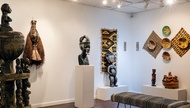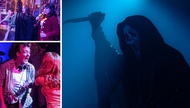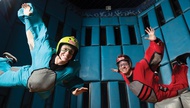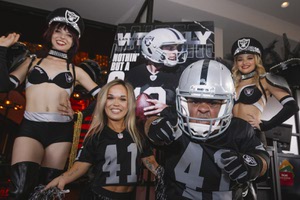There are spoilers ahead. If you’d like to walk into Meow Wolf’s Omega Mart without knowing what lies beyond its grocery aisles, skip this piece until after you’ve visited the Santa Fe, New Mexico-based art collective’s 52,000 square-foot immersive and interactive art installation at the recently opened Area15 experiences, dining and retail mall. You have to see it for yourself.
After that, you can return to this article to learn more about the world of Meow Wolf, though I confess I’m not sure I fully understand it myself. Even the Meow Wolf collective doesn’t seem to have all the answers, or know where the questions are coming from. In Meow Wolf: Origin Story, a 2018 documentary film, one of its members half-seriously claims, “Meow Wolf is this entity that is using us to channel itself into the world.”
Omega Mart is Meow Wolf’s second permanent installation—arriving after Santa Fe’s House of Eternal Return—and their second entry into Las Vegas; the group took over the Life Is Beautiful festival’s Art Motel space in 2017. If you were there, you have some idea what Meow Wolf has to offer: laser harps, portals to the unknown, room-size bowls of “ramen.” The collective has a unique talent for producing and soliciting works of maximalist art, collecting them in warehouse-size spaces with innocuous facades and tying all those artworks together through inventive visual segues and mystery-box narrative.
Meow Wolf’s Omega Mart
Simply put, they build wonderfully weird movies you can walk through.
“Our work is for people that don’t necessarily go to art galleries and art museums, who feel like they want to see artwork and have it [as] an important part of their lives, but might feel a little alienated by the art world,” says Corvas Brinkerhoff, Meow Wolf’s executive creative director. “We’re trying to build a bridge to those people and say, look, art is valuable. And all this brilliant work that all these artists are making deserves to have a place where it can be seen, and where the artists can be supported in the process of making it.
“That’s our model,” he continues. “Instead of looking for a few very wealthy benefactors to support the creation of this work, we’re democratizing it, saying, ‘Everybody is going to support it by paying a little bit of money to come experience it.’ And then we can pass that money on to the artists, and they can be treated fairly for once.”
Meow what?
Let me tell you the one about the time an artist collective walked into a bowling alley. It’s got a bit of a setup, so please stick with me.
In the mid-1990s, Downtown Las Vegas was home to an artist group that called itself the Lower Oakey Collective, or the Lower Oakeys for short. (Most of them lived in a house on East Oakey Boulevard.) They were painters, sculptors, makers, musicians, performers; everything they did had elements of all those disciplines. I remember clearly one of their shows where I was put into a mirrored, coffin-like “time machine” containing fake vine leaves, speakers playing a warbling acoustic guitar and a TV showing a woman doing cartwheels on a grassy lawn. At the end of the clip, the mirror above me was revealed to be two-way glass, and lying on top of it was the woman I’d just seen in the clip, feral and hissing. She’d been in the box with me the entire time.
COVID-19 Protocols
Meow Wolf encourages visitors to buy tickets online beforehand. (Not a bad idea in any case; they could sell out at the door.) Masks that cover the nose and mouth are required. Guests are encouraged to keep a safe distance from other parties, and touchless hand sanitizer stations are provided throughout the property. High-touch surfaces like handrails are cleaned frequently, and the fresh air exchange of the HVAC system has been increased.
Since then I’ve had the pleasure of experiencing several pieces of immersive art. I’ve blissed out inside several of James Turrell’s color rooms, including Las Vegas’ own Akhob at Crystals; made prolonged eye contact with Jordan Wolfson’s creepy pole-dancing robot at New York’s David Zwirner Gallery in 2014; and gone beyond the infinite in a replica of the 2001: A Space Odyssey suite (“The Barmecide Feast,” by Simon Birch and KplusK Associates) at the 14th Factory pop-up in LA in 2016. But I remember the sheer audacity of that Lower Oakeys box—a jolting, singular experience, most of the components of which were probably fished out of a junkyard.
Meow Wolf began much the same way. “We were a volunteer organization for our first seven years,” Brinkerhoff says. Loosely grouped anarchic artists reacting to what they perceived as an exclusionary fine art scene in Santa Fe, members of Meow Wolf pooled their money to rent spaces (the first a “crappy warehouse,” in a not-great part of town, Brinkerhoff says), fished raw materials out of a Salvation Army dumpster and created whatever they pleased.
The scale and ambition of their installations increased over the years, even through internal leadership struggles and outright tragedy, and they sank every penny they earned back into building bigger and more richly layered installations. People lined up by the thousands to enjoy them—even the gallerists of Santa Fe’s fine art scene, who invited the collective to show within their spaces.
Finally, the group decided to get a permanent space. They found an old 20,000-square-foot bowling alley for sale, and on a whim, approached Santa Fe resident and Game of Thrones creator George R.R. Martin with a proposal: If you buy us this decommissioned bowling alley, we’ll build a Victorian-style house inside, riddled with portals to other dimensions. Martin, flush with HBO money, agreed. “A Victorian house, lost in time and space, other dimensions, other times, a secret story you would have to decipher … [they] were pushing all my buttons,” Martin explains in the 2018 documentary. He remains with Meow Wolf in what’s described as a creative advisory role.
The permanent installation, called House of Eternal Return, opened in 2016 and was an immediate hit. Its audience extends far beyond Santa Fe, drawing visitors from all over the world; at press time, more than 10,500 Instagram videos and images bear the #houseofeternalreturn hashtag.
Its success transformed Meow Wolf from a scrappy, local, anarchist collective into an international name in themed entertainment pretty much overnight. Soon after, Meow Wolf began looking to build installations in other cities; Denver was picked first, Las Vegas a short time later. (Meow Wolf Denver opens later this year.)
Yet for all their success, the members of Meow Wolf retain their can-you-believe-we’re-doing-this? mindset. In keeping with its origins, the collective involved Las Vegas’ art scene at the ground level. “There’s such a wealth of artists and performers here, and just so many people for us to collaborate with,” Brinkerhoff says. “We’re always actively trying to undermine our own biases and find new ways to bring artists into the fold.”
And once Meow Wolf selected a group of local collaborators—including Kent Caldwell, Heather Hermann, Jerry Misko, Miguel Rodriguez, Brent Sommerhauser and many others—it got out of their way.
“It’s been really easy to work with them,” says multimedia artist Brett Bolton, who collaborated with illustrator Spencer Olsen on a couple of Omega Mart pieces. (Look for a wormhole-like vortex and “something that looks like it’s going to [steal your] essence and use it for a factory fuel.” Yes, he’s serious, and yes, his description is accurate.) “It’s a crazy machine that they’re building, you know, all the different installations and collaborating artists, and I’m happy to say that it’s been really positive.”
And Vegas artists were paid for their contributions—another big change from Meow Wolf’s hardscrabble beginnings.
How Las Vegas at large will receive Omega Mart is tough to predict. Tourists will flock to see it, of course—the Meow Wolf name is only getting bigger—but local Vegas is not like Santa Fe. Our art scene, both high and low, is much smaller in comparison, and stands in the long shadow of the hospitality industry.
We can boast of dozens of casinos, malls, restaurants and bars that are themed to within an inch of their lives, some of them so legitimately bizarre that Meow Wolf could build a tunnel to them.
It takes a lot to stand out in a city this full of overwhelming, eccentric delights. And, amazingly, Omega Mart pulls it off. I can’t say for sure, but I think even the Lower Oakeys might have been impressed by Meow Wolf’s shoot-the-moon ambitions, and its efforts to incorporate local Vegas artists into its thing.
“It’s so important to us that the community of Las Vegas feels like ‘this is for me,’” Brinkerhoff says.
Wholesale lunacy
Omega Mart is, on its face, a supermarket. It seems normal enough at first glance—aisles of shelf-stable items, a produce section, a butcher counter, even a blood pressure-testing station. But a closer look at the products on the shelves reveals that something is … off. The “Old Caltucky Style” barbecue sauce—I’m sorry, “Freedom Glaze”—promises “smoky mesquite vigilance.” The deli meats are sliced open to reveal cosmic dust and Edvard Munch’s “The Scream.” The dairy section is malfunctioning; cartons of milk and butter are stretched out in one long digital glitch. And the garden area—located just beneath custom-made piñatas by Justin Favela, depicting the Seven Deadly Sins—offers “Armed Daffodils,” a cheery flower with a prehensile “arm” at its center.
Getting to Area15
Though it’s readily visible from Interstate 15—on the west side of the freeway, between Palace Station and Chinatown—actually driving to Area 15 takes some doing. If you exit onto Spring Mountain Road West, turn right on Aldebaran Avenue, then right again when it ends at the Desert Inn Arterial exit ramp. That’ll put you onto Rancho Drive, mere feet from the property. If you exit onto West Sahara Avenue, turn left onto Rancho, and be careful not to take the freeway ramp. (Of course, as Meow Wolf’s Corvas Brinkerhoff notes, once we all have AI-driven cars, directions won’t matter anymore.)
You could easily lose a half-hour wandering the market shelves, enjoying all the wordplay, puns and double entendres Meow Wolf packed into its salable goods. (According to the box, the Armed Daffodil is “nature’s handsiest flower.”) But all that abnormal retail had to come from somewhere, and soon enough, you find them: portals to other places. One snakes into the refrigerated section, like pulled taffy; another opens into the garden section, past flowers with eyeballs and toothy expressions of surprise. (It’s a teeny bit creepy.)
Walk through these portals and … wow. The market section of Omega Mart is good-sized, but it’s completely surpassed by the vast spaces that sit on the other side of those portals. There’s a wavy, seemingly melting desert landscape, whose psychedelic grandeur is accentuated by an original Brian Eno score; it flows into a multiple-story factory space, whose musical pulse was created by Amon Tobin. (Other big musical names adding their vibes: Beach House and Santigold. Pitchfork was impressed enough with Meow Wolf’s Vegas soundtrack to make note of it.)
And both of those spaces—along with a darkly futuristic warren of “corporate offices” and a few other spots I’m not telling you about—are packed with enough maximalist art, interactive pieces and raw story to make your three-hour visit rush by. Everywhere you turn, there’s something begging to be noodled with.
(Meow Wolf is taking the utmost cautions with surfaces and crowding during the pandemic; see Page 13. But be aware that there are some tight spaces and touchable objects.)
Brinkerhoff notes that there are several giant stories unfolding within the space, including those of a shadowy corporation (Omega Mart’s parent company “Dramcorp”). Brinkerhoff says it’s “trying to save humanity from itself” by experimenting with what looks like alien technology. A zealous resistance group—shades of Meow Wolf’s beginnings here—is standing against these corporate overlords wielding what little it has.
There are RFID-accessed computer terminals and old-fashioned phones scattered throughout that yield clues to the mystery (Brinkerhoff says the phones mostly deliver recorded messages, though “you also might get a live human”), and videos that advance the story—about three hours’ worth of original footage.
You’ll have to return to this otherworld several times to begin to unravel all these threads.
That said, you’ll want to come back just for the art. Claudia Bueno’s “Pulse,” made from multiple sheets of etched glass, shimmers like sunshine dancing on a lake. Carey Thompson and Brian Pinkham’s “Juke Temple” plays hypnotic games with color and shape. And I’m a big fan of “Vibration Elevator,” conceived by Brinkerhoff himself. It’s a truly odd hybrid of discotheque, photo booth and X-ray machine—a room of strobing lights that throws fleeting images of its inhabitants onto its walls between pulses. “It’s sort of anti-narrative, anti-intellectual,” Brinkerhoff says.
Though “there’s something here for everyone” is timeworn cliché, it’s close to accurate here. Aficionados of high art will discover at least a few things that fascinate them; lovers of high-concept art should find even more. Music geeks will trip out on what could be taken as visual albums, while cinephiles will marvel at the visuals and plot elements. Kids will love all the sights and sounds, plus the giant slides that corkscrew down the factory room. (Some, er, adult journalists might have enjoyed the slides, too.) And it probably goes without saying that you can Instagram the hell out of the place.
Omega Mart opens in Las Vegas at a strange time, and not just because of COVID-19 restrictions and the virus’ chilling effect on our city’s multimillion-dollar entertainment scene. People’s motivation for visiting Vegas was changing even before the Valley locked down last March: Gaming revenues were shrinking while new restaurants and bars proliferated, and the arrival of professional sports literally remade the city skyline.
We’ve become a place for superstar residencies, foodies and interstate tailgates. It’s been many years since we’ve had anything like a wholly immersive themed space (Star Trek: The Experience at the Las Vegas Hilton, 1998-2008) or a tourist-focused art museum (the Guggenheim Hermitage Museum at the Venetian, 2001-2008).
Meanwhile, our local art scene is showing uncommon resilience in the face of disaster. Galleries are holding distanced or virtual openings, and UNLV’s Barrick Museum is soldiering on. In the preceding years, giant-scale art has been steadily invading the Strip and Downtown: a Jenny Holzer piece at Aria, a Shepard Fairey on Fremont Street, a Georges Rousse at the Cosmopolitan. Perhaps Las Vegas is ready for something as surprising, peculiar and unclassifiable as Meow Wolf. And Meow Wolf, through years of hard work and a gentle push from the Father of Dragons, is ready to win over Las Vegas and stay here awhile; Brinkerhoff says the group has “at least 10 years’ worth of space” to expand into at Area15.
“When we started out, [it] was really about creative exploration … and it sort of evolved into this immersive experience design,” Brinkerhoff, gesturing around the spectacular desert room. “I feel like there are more colors on the palette now—all of this technology and immersive storytelling, being able to work at this scale and with amazing collaborators. It just gets more and more fun.”
Meow Wolf’s Omega Mart Monday-Thursday, 3-9 p.m.; Friday, 3 p.m.-midnight; Saturday, 10 a.m.-midnight; Sunday, 10 a.m.-8 p.m.; $30-$45. Area15, 3215 S. Rancho Drive, 725-241-6300, meowwolf.com/visit/las-vegas.











